Mastering Crystal Photography and Identification Techniques
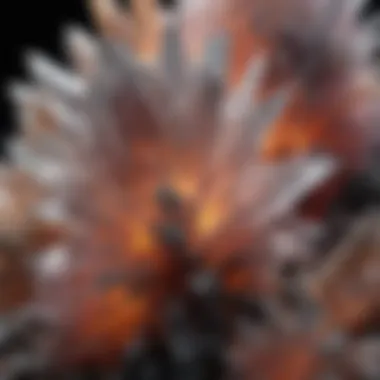
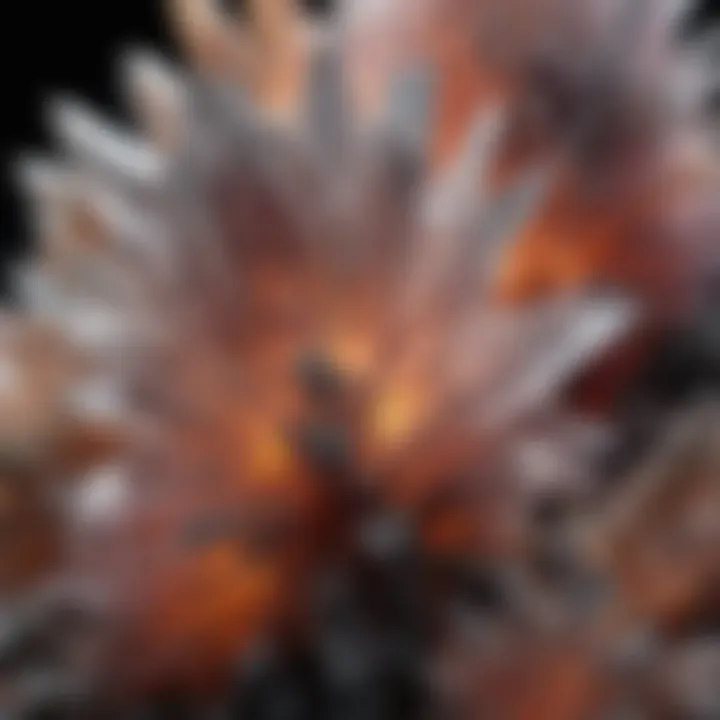
Intro
Crystals have long captivated the human spirit, shimmering under the vast sky with stories layered in their crystalline formations. For enthusiasts and collectors alike, learning how to effectively photograph and identify these natural wonders opens up a whole new world. This journey delves into the nuances of capturing those vibrant hues and intricate details that set each crystal apart, while also arming you with the knowledge to recognize their unique characteristics.
Understanding crystals is more than just a hobby; it’s a passage into the earth’s narrative, revealed through geology and artistry combined. Photography becomes not just a means of display, but a bridge to appreciation and deeper understanding.
In the following sections, we will cover various aspects of gemstones, their properties, and practical methods to enhance both your photography skills and identification techniques. Get ready to unlock the brilliance hidden within each crystal!
Understanding Crystals
Grasping the nature of crystals is foundational for anyone keen on crystal photography and identification. Understanding crystals allows enthusiasts to appreciate their beauty and distinctiveness, while also preparing them to accurately capture their essence through the lens of a camera.
The allure of crystals lies not only in their aesthetic appeal but also in the geological and chemical narratives they hold. Each crystal tells a story from its formation to its current appearance. By recognizing the various characteristics that define these natural wonders, collectors and photographers alike can enhance their techniques and knowledge.
Furthermore, understanding the types and structures of crystals aids in their identification; which, in turn, enhances the efficiency of photographing them. Inadequate understanding could lead to misrepresentation or misidentification of the crystals, which can be greatly frustrating for both collectors and photographers.
What are Crystals?
Crystals are solid materials whose constituent atoms, molecules, or ions are arranged in an orderly repeating pattern extending in all three spatial dimensions. They often exhibit impressive clarity and brilliance, capturing light in ways that can be mesmerizing. Each of these structures reflects a unique arrangement that can be related back to its formation process.
In nature, the process of crystallization can occur from a variety of states: from cooling magma, evaporating salt water, or even during the gradual cooling of liquids. These processes lead to myriad forms that can vary vastly in aesthetic.
Types of Crystals
Understanding the different types of crystals is pivotal. Each variation comes with its own defining features that impact both visual appearance and practical applications. Here, we examine three primary categories:
- Natural Crystals: These are naturally occurring crystalline forms that manifest in environments through geological processes. A key characteristic of natural crystals is their unique forms and imperfections, which can make them quite different from synthetic alternatives. They often showcase intricate patterns, and the 'flaws' can give insight into their growth environment.
While their beauty is indisputable, natural crystals can also be harder to identify due to superficial similarities among various types. Not only do they add authenticity to collections, but they also imbue a piece with history and connection to the Earth. - Synthetic Crystals: Unlike natural crystals, synthetic crystals are man-made, providing a controlled and consistent process for their creation. A notable advantage of synthetic crystals is their availability and often, their cost-effectiveness. They can be manufactured to exact specifications, matching the desired visual characteristics without the variability sometimes found in natural samples. However, some purists view synthetic crystals as lacking the natural charm of their counterparts.
- Mineral Crystals: These are crystalline forms resulting from mineral processes and typically represent particular elements or compounds within the Earth. They are often Hardy and can serve various industrial applications beyond mere aesthetics. Mineral crystals allow for a practical perspective, as their qualities can serve as indicators of the environments they originate from. The challenge remains in distinguishing them, as mineral crystals can resemble one another closely.
Crystal Structures
The structure of a crystal can reveal much about its properties and behavior. Understanding these structures allows photographers to visualize the angles and shapes in their images effectively.
- Cubic: Cubic structures are among the simplest and most symmetrical. Each face is a square, and the internal angle is uniform at 90 degrees. Because of high symmetry, these crystals generally display remarkable clarity and polish. Their even distribution of light makes them ideal for photography, effortlessly catching the eye. While their uniformity simplifies identification, they may lack the unique intricacies found in more complex structures.
- Tetragonal: Slightly more complex than cubic, tetragonal structures maintain a square base but differ in height. The unique characteristic of these crystals is the elongated shape, which may present challenges regarding capturing accurate images without distortion. This leads to fascinating angles that can draw out very different feelings or moods within photography.
- Hexagonal: These crystals are defined by a six-sided prism shape, showcasing striking angles and a diverse range of colors. The hexagonal pattern, at times, might make them appear less uniform than cubic structures, adding an artistic twist to their representation. Their structural complexity can result in captivating photography displays, providing richness to any collection.
"The unique beauty of crystals is enhanced by their incredible structures, revealing nature's artistry in an unexpected light."
Understanding different types and structures of crystals paves the way for effective capturing and identification techniques. With this foundational knowledge, the journey into crystal photography and identification only becomes more interesting.
The Importance of Photography in Crystal Identification
Photography plays a crucial role in the realm of crystal identification. Consider it the vital first step in documenting what you find and sharing that with a community of fellow enthusiasts. By taking a sharp, clear photograph, one captures nuances that the naked eye might miss -- slight inclusions, vibrant shades, or unique facets that are critical for proper identification. This method not only serves as a point of reference for personal collection but acts as a bridge to other hobbyists who might help in the identification process, enhancing the overall learning experience.
Why Photograph Crystals?
Photographing crystals allows one to freeze a moment, harvesting rich detail that can contribute immensely to identification efforts. Well-taken images capture variations in color and texture that could be essential in distinguishing one crystal from another. Additionally, high-quality photographs can reveal aspects of a crystal not evident in poor lighting. The ability to share these images on forums or with collectors broadens a crystal enthusiast's understanding and increases the chances of accurate identification through community input. Think of it as a visual resume for your crystal.
Fundamental Photography Techniques for Crystals
Lighting
Lighting is a critical factor in crystal photography and can make or break a shot. Natural light often shines the brightest here, showcasing the crystal’s true colors without the harsh shadows or distortions common with artificial sources. A spot by the window can become your best friend, letting sunlight illuminate those stunning inclusions. However, this sunlight needs controlling. Too strong of light can wash out details, while too little can make the crystals appear lifeless. Utilizing diffusers or reflectors can help manipulate the light to your advantage, creating an engaging image that highlights the crystal's best features.
Background Selection
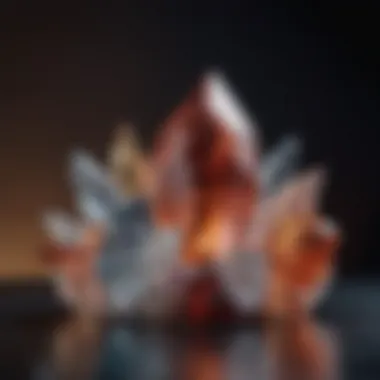
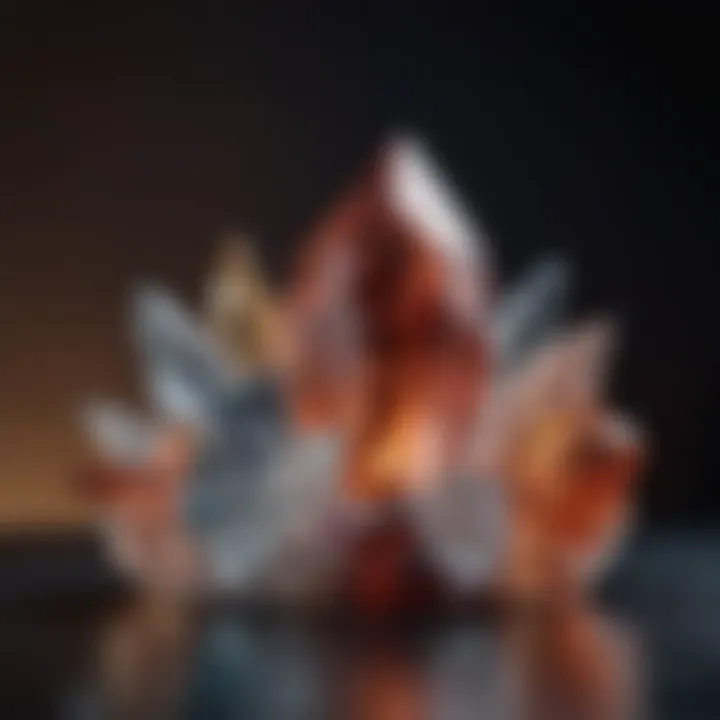
The background of a crystal photograph should complement, not compete with the subject. A good choice is often a neutral color that contrasts effectively with the crystal's colors. For example, a dark blue backdrop can make a citrine pop, while a white background might give an ethereal look to clear quartz. Consider the textures as well; a smooth granite counter can bring depth without overshadowing the crystal's brilliance. One might find it tempting to choose something flashy, but the goal in this case is clarity; the background should enhance, not detract.
Focus and Depth of Field
Focus is paramount when it comes to crystal photography. The crystal should be the main subject and in sharp detail, drawing the viewer's eye instantly. This often requires experimenting with depth of field, ensuring the entire crystal, especially if it has intricate facets, is in focus while blurring the background to create emphasis. A wider aperture can work wonders here, allowing for a beautifully blurred background that accentuates the crystal’s significant attributes. Emphasizing this can lead to stunningly professional images that tell a closer story.
Common Tools for Crystal Photography
Cameras
The camera is, of course, a pivotal tool in the process. While many enthusiasts start with a smartphone, a digital single-lens reflex (DSLR) or a mirrorless camera can greatly improve image quality. The main allure of these cameras lies in their various settings, flexibility, and potential for interchangeable lenses. Higher megapixels contribute to clear, crisp images.
Lenses
Different lenses can accentuate various features of crystals. A macro lens, in particular, is a favorable choice for capturing intricate details without the need to crop extensively, which can result in loss of quality. Categories such as wide-angle lenses provide unique perspectives, enabling some interesting compositions. Understanding the characteristics of your lens can unlock new ways to showcase each specimen's fine details.
Tripods
Chelsea has often found that stability is key when dealing with crystals. A good tripod ensures that every shot is steady, allowing for longer exposure times without risking blur. This setup is especially beneficial in lower-light scenarios, where shaky hands would otherwise jeopardize the shot. Additionally, there are various types of tripods available, each designed for specific conditions, so choose one that suits your needs best.
"Good photography not only reveals what the eye can see, but also what it cannot."
In sum, photography is more than snapping a picture; it's an art that involves capturing the essence of these mineral wonders. With the right techniques and tools, you can translate their beauty into images that assist in identification and exploration within the vast world of crystals.
Capturing Your Crystal
When it comes to documenting the allure and intricacies of crystals, capturing them through photography is more than just snapping a picture. It’s about translating their beauty and complexity into a two-dimensional medium where their essence can shine. The art of crystal photography serves a purpose beyond mere aesthetic appreciation; it bridges the gap between the enthusiast and the scientific observer. By effectively showcasing a crystal’s features, we provide a foundation for accurate identification and appreciation.
Setting Up the Scene
Before you even think about clicking the button on your camera, you need to set the stage. Much like a director setting the mood for a film, the scene you create will dictate the narrative your photograph tells. You want a background that compliments, not overwhelms, the delicate details of the crystal.
Consider these tips for creating an optimal setup:
- Choose Simple Backgrounds: Opt for muted colors or textures that pull the viewer's focus to the crystal. A stark white or soft gray backdrop can work wonders.
- Natural Light: If possible, use natural light to highlight the crystal's facets. Early morning light is often softer, creating subtle shadows and enhancing the surface texture.
- Stability: Ensure your camera is stable; any movement will introduce unwanted blurriness. A sturdy tripod is highly recommended.
Taking the Perfect Shot
Angles and Perspectives
The angle from which you choose to photograph a crystal can make or break the shot. Misjudging the angle could result in losing the distinct characteristics that make your crystal unique. Try to experiment with various angles: a shot from above can highlight the symmetry of many crystals, while a side angle often reveals depth and texture.
"Angles can tell different stories about the same object, much like different perspectives in a conversation."
The focus on angles and perspectives encourages a viewer to see the crystal in a new light. Each angle emphasizes different aspects—from sparkle to clarity and color. A major plus is that it allows you to showcase multiple features in one session, making it a go-to technique for crystal photography. Alternatively, too tight of a focus can simplify the beauty into an unrecognizable form, limiting the viewer's appreciation.
Adjusting Camera Settings
Having the right camera settings is crucial in capturing the essence of a crystal accurately. The interplay of shutter speed, ISO, and aperture can greatly affect the final image.
Setting a low ISO can minimize noise, while a larger aperture (a smaller f-stop number) offers a shallower depth of field, creating beautiful bokeh around your crystal. This draws the eye more intimately toward the crystal itself, creating a focal point amidst a dreamy background.
However, manipulating camera settings is not all straightforward. Beginners might find it daunting but with practice, it becomes second nature. The key takeaway here is to understand how each setting interacts with the other—much like a well-oiled machine, each cog turns in synergy for optimum performance.
Post-Processing Techniques
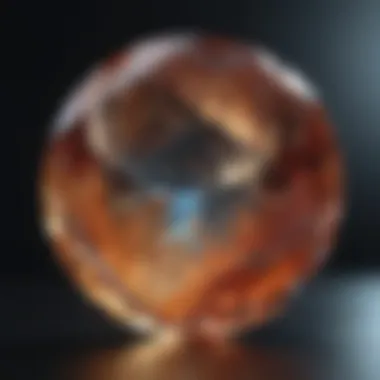
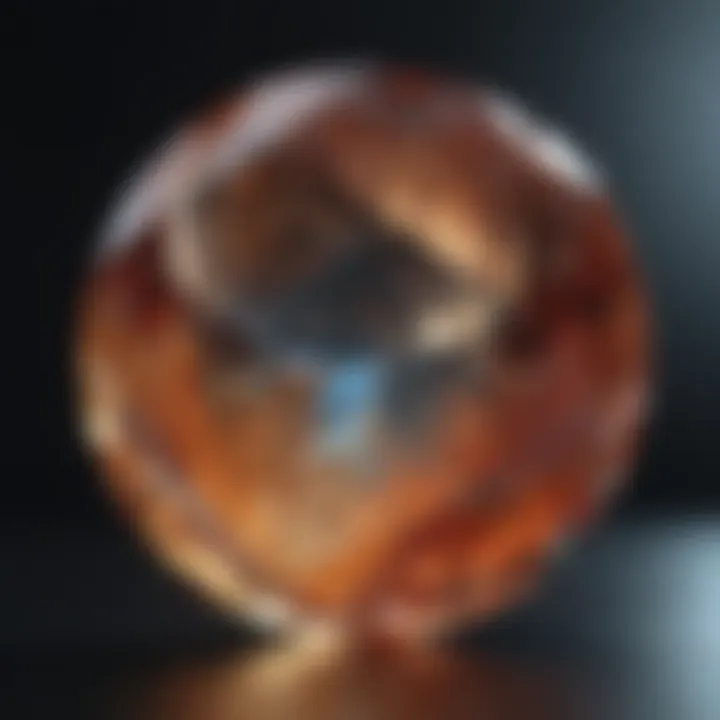
Editing Software Options
Once you’ve taken your shot, it’s time to enter the digital realm of post-processing. Various editing software can enhance your images significantly. Programs like Adobe Lightroom and Photoshop are powerful tools, allowing for adjustments in exposure, sharpness, and color.
What warrants closer attention is to maintain the integrity of the crystal's details while manipulating tones and contrasts. Over-editing could mislead viewers regarding the crystal's true colors, potentially skewing identification efforts.
Enhancing Color and Clarity
One of the main goals of editing is to enhance color and clarity. This involves adjusting the vibrancy and saturation to make the crystal pop, while ensuring that real-life colors remain intact. When you improve clarity, you're ensuring that the intricate details of the crystal’s facets are pronounced.
Utilizing these post-processing techniques doesn’t just polish the picture; they convey a higher level of professionalism in your work. Remember, you want to present an accurate depiction of the crystal while still maintaining visual appeal.
Identifying Your Crystal
Identifying your crystal is not just a matter of looking at it and saying, "Hey, that's pretty!" The process involves discerning the various characteristics that make each crystal unique. It’s a bit like piecing together a puzzle where every facet contributes to the whole picture. Proper identification can enhance your appreciation for these natural wonders and improve your collecting or crafting endeavors. Not to forget, being able to accurately identify your crystals can also safeguard your investments, especially for collectors, who put a lot of money into rare specimens.
Visual Characteristics of Crystals
Color Variations
The world of crystals is full of color; each shade tells a story. Crystal colors can range from the deep blue of lapis lazuli to the vivid greens of malachite. Color variations are pivotal because they help in quickly narrowing down the possible identities of a crystal. For instance, knowing that a particular stone has a striking purple hue can lead you straight to amethyst instead of spending time on more common stones.
Each color can also hint toward the crystal's origins and the conditions under which it was formed. In some cases, colors reflect impurities that are trapped within the crystal structure, making each specimen unique. However, while color can be a guiding factor, it’s worth keeping in mind that not all color variations are reliable for identification. A common pitfall is mistaking a dyed stone for its natural counterpart, which can lead to misidentification.
Transparency Levels
Turning your attention to the transparency of a crystal, you’ll find this aspect can break things down even further. Some stones, like quartz, can be found as either transparent or completely opaque, creating a clear distinction in identification. Transparency levels can influence not only the identification process but also the crystal's value. A transparent specimen often fetches a higher price than a cloudy one because it denotes a higher quality and purity.
Understanding the degree of transparency can help you recognize other features too, such as luster and brilliance. However, keep an eye out: certain crystals may appear transparent until they're cut and polished, then revealing their true opaque nature. Thus, transparency speaks volumes but must be considered alongside other characteristics, giving you a fuller picture.
Surface Texture
Surface texture can be the unsung hero of crystal identification, often overlooked but filled with crucial insights. You might think you're looking at stone that is smooth but may find that closely inspecting reveals nicks, patterns, or other irregularities that can inform you of its geological history or authenticity.
From the glass-like finish of a polished crystal to the raw, natural state of others, surface textures can greatly impact how a crystal behaves with light and even how it resonates energetically. For example, rough textures might indicate that the crystal hasn't been treated or polished, whereas shiny surfaces suggest human intervention.
Additionally, keep in mind that surface texture can affect how a crystal’s color is perceived. A matte finish might dull vibrant hues, while a glossy one can amplify them.
Utilizing Reference Guides
When delving into the world of crystals, reference guides become your steadfast allies. They offer established frameworks for comparing your findings against known features of various crystals. These can range from books that delve deep into the geology of crystals to concise pamphlets that outline key identification tips. A good guide can teach you to notice the subtleties of crystal traits, something that can turn novice hobbyists into knowledgeable enthusiasts.
Online Resources for Crystal Identification
Websites
Several websites serve as treasure troves of information about crystals, complete with images and detailed descriptions. Sites like mineralogical databases or geological surveys allow you to search for specific crystals, providing insights into their unique properties, formations, and even geographic locations where they might be found. These resources can offer visuals that help solidify your understanding, making them an invaluable tool in your identification arsenal.
Mobile Applications
In today’s tech world, mobile applications have revolutionized how enthusiasts can identify crystals quickly and accurately. Apps designed for mineral identification often feature user-friendly interfaces and databases that you can access right from your pocket. They may allow you to take a picture of your crystal and receive instant feedback on its type. This ease of access has made mobile applications a popular choice for both casual and serious collectors, as they make knowledge readily available at any moment.
Forums and Community Insights
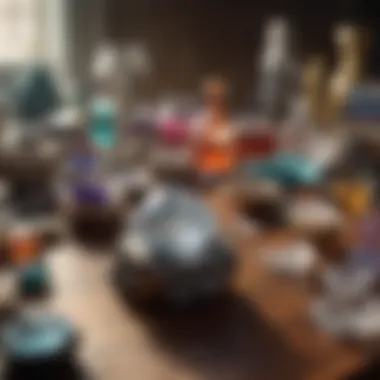
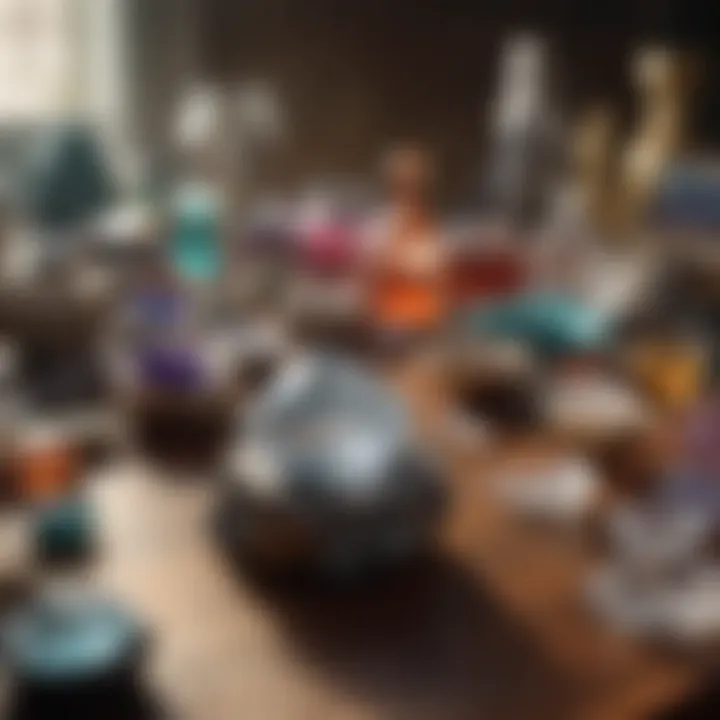
Last but not least, online forums and community insights are where the collective wisdom of crystal enthusiasts shines. Here, individuals share their experiences, give advice, and discuss challenges in crystal identification. These forums can help bridge the gap between resources and real-world experience, giving you access to a wealth of perspectives. Whether it's a local gem show or a community group on social media, connecting with like-minded individuals will enrich your understanding and broaden your identification skills.
Challenges in Crystal Identification
Identifying crystals can be a tricky endeavor, even for the most perceptive collectors. While the beauty and complexity of crystals often enchant enthusiasts, the process of accurately determining their type can pose some challenges. This section delves into the common pitfalls and photography-related issues that might complicate the identification journey, emphasizing the significance of being aware of these obstacles for a clearer understanding of crystals.
Common Misidentifications
Misidentification of crystals is a headache many collectors face. For instance, some may mistake citrine for topaz due to their similar yellow hues. This confusion often arises from a lack of detailed examination within the right context. A beginner might not recognize that color alone does not define a crystal's identity—its structure and other properties play crucial roles. Crystals can often display a range of colors influenced by environmental factors or inclusions, complicating the identification further.
To prevent these mix-ups, enthusiasts should employ a more methodical approach, looking beyond basic characteristics. Relying on visual aids, such as comprehensive reference guides, can help clarify distinct features like crystallography or hardness that might separate similar-looking specimens.
Limitations of Photography
While photography serves as a powerful tool in crystal identification, it is essential to recognize its limitations, particularly with respect to lighting and resolution.
Lighting Conditions
Lighting plays an integral role in revealing the true colors and details of a crystal. Different sources of light can create various effects, sometimes obscuring features crucial for proper identification. For example, natural daylight can enhance the transparency and brilliance of a crystal, while fluorescent light may introduce artifacts, misleading the observer.
- Artificial vs. Natural Light: Natural light tends to provide a more accurate representation of color and clarity. In contrast, artificial lighting can lead to distortions that mask the crystal's properties.
- Direct vs. Diffused Lighting: Direct light may cause glare, making it tough to see surface textures, whereas diffused lighting often softens shadows and reveals intricate details.
Choosing the right lighting is a balancing act; too little light can lead to underexposition, losing key details, while too much light can wash out specific features. Therefore, understanding and manipulating lighting conditions becomes paramount in the capturing and identification process.
Resolution Issues
Resolution is another factor that becomes a stumbling block during crystal photography. High-resolution images allow for close examination of intricate details, which aids in accurate identification. When a photograph lacks clarity, small but significant features, such as striations or inclusions, may not be discernible.
- Importance of High Resolution: A high-resolution image enables enthusiasts to analyze features closely, which is often the difference between correctly identifying a crystal or mislabeling it.
- Common Mistakes: Even seasoned photographers might forget to adjust their settings for optimum resolution, leading to blurry or pixelated images that fail to provide necessary detail.
While resolution can often be scaled up in post-processing, it is best to start with a solid foundation. Paying careful attention to this aspect can save time and effort in the long run, ensuring a more reliable identification process.
"A well-captured image is worth a thousand poorly taken ones; clarity matters in the world of crystals."
By navigating through these challenges, crystal enthusiasts can refine their skills and knowledge, elevating their identification practices to new heights.
Connecting with the Community
Engaging with others in the realm of crystal photography and identification can be a rewarding experience. Sharing knowledge and discoveries not only bolsters individual understanding but also fosters a sense of belonging. Enthusiasts, collectors, and even casual hobbyists can gain significant insights from communal interactions. This section will delve into how these connections can enhance your journey.
Sharing Your Findings
With the advent of social media, sharing your captured images and findings has never been easier. By displaying your work on platforms like Instagram or dedicated crystal forums, you invite constructive feedback and suggestions from a global audience. This not only helps in refining your skills but also opens up doors to new methods of identification or even places to find rare specimens.
Consider setting up a dedicated portfolio or blog to showcase your visuals. This acts as a personal diary of sorts, documenting your growth and experiences while also inspiring others in the community. Such sharing isn't just about showing off your latest beautiful rose quartz; it can spark discussions, friendships, and collaborations.
Participating in Crystal Identification Groups
Being part of a group that shares your passion can enhance your learning experience in numerous ways. Whether it's local meetups or online platforms, these groups can serve as invaluable resources.
Local Meetups
Local meetups offer a face-to-face opportunity to connect with fellow enthusiasts. The key characteristic of these gatherings is the direct interaction with people who share your love for crystals. At a local meetup, you can exchange tips on photography, swap tools, or even trade samples. The unique feature of such meetups is the tactile experience—holding a crystal and examining it under various light conditions provides insights that a photo may not capture. However, they may require commitment in terms of travel and schedule.
Online Platforms
On the flip side, online platforms are bursting with opportunities to engage with a wider audience—a characteristic that makes them quite popular. Websites like Reddit have dedicated subreddits for crystal enthusiasts, where you can ask questions, share your work, or simply observe and learn from others. These platforms allow for asynchronous communication, meaning you can participate at your own convenience. A downside might be the occasional overload of information and the difficulty in sifting through it for valuable insights.
"The more we share, the more we gain—knowledge grows exponentially in community."
Connecting with others in this field enriches both your practice and understanding of crystals. Be it a casual meetup or an online discussion forum, each interaction offers a chance to learn something new and valuable.



